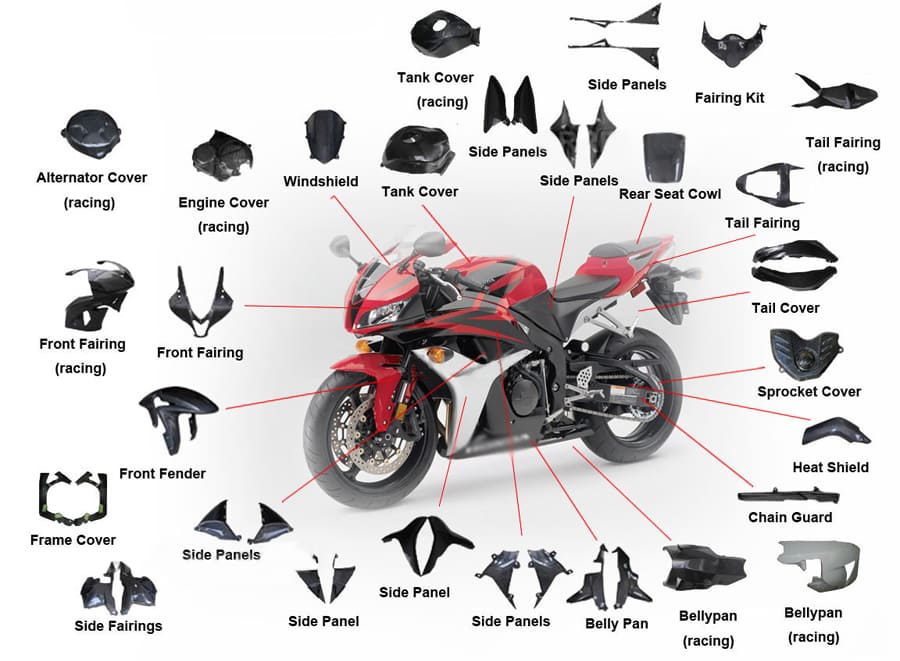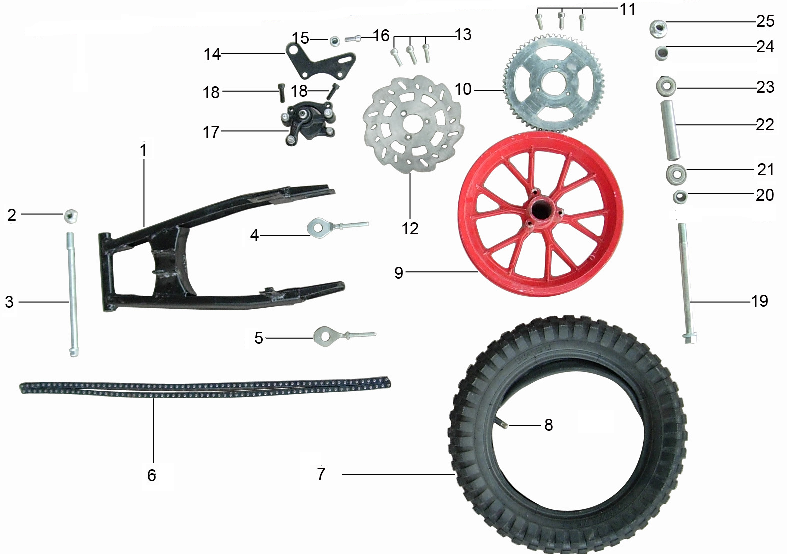What Makes High-Grade Motorcycle Parts Auckland Essential for Daily Commuters
A Comprehensive Overview to Choosing the Ideal Bike Components for Your Ride
Picking the right bike components is crucial for any kind of cyclist. Each element plays a significant function in enhancing performance and convenience. Recognizing the type of bike and its desired use is essential. From handlebars to tires, every detail issues. This overview will certainly check out the crucial aspects of selecting these parts. The ideal selections can boost any kind of trip, but what details elements should one think about to achieve the very best outcomes?
Recognizing Bike Types and Their Parts
Just how can one choose the best bike components without understanding the various kinds of bicycles? Each bicycle type-- hill, roadway, hybrid, and cruiser-- functions unique components customized to its details function. Mtb, as an example, are geared up with robust frames and broader tires for off-road security, while road bikes prioritize lightweight products and wind resistant layouts for speed on paved surfaces.Hybrids blend components from both mountain and roadway bikes, supplying convenience for different terrains. Cruisers, made for comfort, function wider seats and handlebars for a much more loosened up riding placement. Each kind additionally utilizes distinct gear systems, brakes, and wheels that deal with their designated use.Understanding these distinctions is crucial for picking compatible and efficient bike components. A biker's selection can notably boost performance, safety, and total enjoyment. By recognizing the qualities of each bicycle type, one can make enlightened choices when updating or changing parts.
Secret Considerations for Deciding On Handlebars
When picking handlebars, a biker must take into consideration numerous factors that can considerably influence convenience and control. One key consideration is the width of the handlebars, as it influences stability and take advantage of during rides. Bigger handlebars generally supply better control, specifically in technological terrains, while narrower ones may enhance the rules of aerodynamics for racing.Additionally, the increase or decline of the handlebars impacts the cyclist's posture. Greater handlebars promote a more upright position, minimizing strain on the back, while lower ones can enhance the rules of aerodynamics. The shape of the handlebars is also vital; options like flat, riser, or decrease bars satisfy various riding designs and preferences.Material is another essential variable, with aluminum and carbon fiber being prominent for their equilibrium of weight and sturdiness. Eventually, the appropriate handlebars must align with the cyclist's intended use, guaranteeing a pleasurable and effective cycling experience.
Choosing the Right Saddle for Comfort and Efficiency
Choosing the right saddle is necessary for optimizing convenience and performance during experiences. An appropriate saddle can substantially affect a cyclist's experience, directly impacting energy levels and general enjoyment. When selecting a saddle, elements such as shape, size, and cushioning must be carefully taken into consideration. The saddle's size must align with the motorcyclist's sit bone measurements, guaranteeing ample assistance. Furthermore, padding choices differ amongst riders; some might like very little padding for a much more direct connection to the bike, while others might look for deluxe padding for enhanced convenience on longer adventures. Saddle form likewise plays a crucial duty, as it influences the circulation of stress during pedaling. In addition, materials utilized in construction can impact weight and longevity. Inevitably, testing various saddles is vital, as personal comfort varies substantially. A thoughtful approach to saddle choice can bring about improved performance and a more delightful biking experience.
The Importance of High Quality Tires for Various Surfaces
Choosing the appropriate tires is important for optimal efficiency throughout numerous surfaces. Different surfaces require specific tire attributes, such as tread patterns and rubber substances, to ensure grip and sturdiness. Additionally, the longevity and strength of tires can significantly influence a cyclist's total experience and safety on the roadway or path.

Terrain-Specific Tire Features
How does the terrain influence tire performance? Various terrains need distinctive tire attributes to maximize efficiency and safety. Hill biking on rough tracks needs tires with hostile step patterns to supply grasp and stability. On the other hand, roadway cycling on smooth surface areas benefits from narrower tires that reduce rolling resistance.In wet or muddy conditions, tires developed with deeper grooves can direct water properly, protecting against hydroplaning. Additionally, softer compounds may enhance traction on slick surfaces, while tougher substances use longevity on rough paths. Understanding these terrain-specific tire features is essential for cyclists intending to boost their riding experience. Picking the proper tire not just influences taking care of however likewise general convenience, making it essential for riders to match their tires to their intended surface.
Tire Sturdiness and Efficiency
Quality tires significantly affect a biker's efficiency and security throughout various surfaces. The resilience of tires is necessary for enduring the rigors of various surface areas, from tough trails to smooth roadways. Better tires usually navigate to this site include reinforced sidewalls and progressed rubber substances, which improve their durability and hold. As an example, tires created for off-road conditions generally have deeper footsteps that supply far better grip on loosened surfaces, while road tires focus on a smoother account for lowered rolling resistance. In damp conditions, tires with specialized step patterns can enhance handling and reduce the threat of hydroplaning. Ultimately, buying high quality tires tailored to details riding settings can significantly boost general biking experience, ensuring both efficiency and safety.
Gearing Solutions: Discovering the Perfect Suitable For Your Riding Design
While numerous bicyclists understand the significance of an excellent bike structure or wheels, the gearing system plays an essential duty in enhancing efficiency and convenience on the road or path. Selecting the right tailoring system depends mostly on private riding style and surface. Roadway bicyclists frequently benefit from a small gearing configuration, enabling for smoother changes and higher rates on flat surfaces. In comparison, hill bicycle riders might like a larger series of gears to deal with high climbs and rough descents.Cyclists need to additionally think about the number of gears; a 1x system streamlines changing and lowers weight, while a 2x or 3x system supplies adaptability for different surfaces. Recognizing gear proportions is essential, as reduced ratios help with simpler pedaling uphill, while greater proportions support speed on flat stretches. Eventually, the ideal gearing system harmonizes with the cyclist's preferences, making certain a effective and delightful biking experience.
Enhancing Your Adventure With the Right Brakes
Choosing the proper stopping system is as crucial as selecting the ideal tailoring for a bike. The top quality and kind of brakes can considerably influence a biker's control, safety and security, and general riding experience. Bicyclists commonly deal with a choice in between edge brakes and disc brakes. Rim brakes are typically lighter and simpler to preserve, making them a preferred option for roadway bikes, while disc brakes use remarkable stopping power and efficiency in different weather, perfect for mtb and visiting setups.Moreover, brake pads play a vital role in braking performance. Picking the right material-- such as natural, metal, or semi-metallic-- can enhance performance based upon riding problems and personal preferences. Furthermore, appropriate placement and routine upkeep of the braking system assurance reliable efficiency and long life. Eventually, investing in the ideal brakes customized to individual riding styles can boost safety and pleasure on every trip.
Updating Devices for a Better Cycling Experience
Updating accessories can substantially improve a bicyclist's experience on the roadway. Important security equipment, such as lights and headgears, incorporated with convenience improvements like padded seats and ergonomic grips, can make a noteworthy distinction. These upgrades not just boost security yet also advertise longer and much more delightful trips.
Essential Security Equipment
Security gear is an essential element of a bicyclist's arsenal, enhancing both protection and comfort when traveling. Helmets are the most read this post here essential product, significantly lowering the threat of head injuries in situation of a crash. High-visibility clothes and devices, such as reflective vests and lights, ensure that cyclists continue to be noticeable to vehicle drivers, especially in low-light problems. Gloves offer grasp and reduce the possibility of sores, while knee and joint pads can offer added defense during drops. Selecting ideal shoes with a great hold can likewise improve safety while cycling. Buying quality security equipment not only advertises a much safer ride however likewise increases a bicyclist's self-confidence, enabling them to appreciate their biking experience to the fullest.
Convenience Enhancements and Upgrades
Bicyclists commonly look for to improve their riding experience beyond standard safety and security actions. Convenience enhancements and upgrades play a vital role in achieving this objective. Among one of the most considerable upgrades is a premium saddle, made to offer maximum assistance and lower pain during longer trips. In addition, handlebar grasps that offer far better ergonomics can reduce pressure on hands and wrists. Investing in padded biking shorts can furthermore improve convenience by minimizing rubbing and pressure points. Moreover, shock-absorbing seat posts and broader tires can boost trip top quality by moistening resonances from rough terrain - Bike Parts Wellington. Changing the bike fit guarantees that placements are ideal for private riders, leading to an extra pleasurable and comfy biking experience.
Regularly Asked Inquiries
Exactly how Do I Maintain My Bike Components for Durability?
Preserving bike parts for long life includes routine cleansing, lubrication, and inspection. Correct storage space away from moisture, prompt replacement of worn elements, and adherence to producer standards can substantially improve the life expectancy and performance of the bicycle.
What Tools Do I Required for Bike Part Installation?
To install bike parts properly, one typically requires essential tools such as wrenches, screwdrivers, tire levers, a multi-tool, and a pump. These instruments help with appropriate setting up, ensuring optimal performance and durability of the bicycle components.
Exactly how Often Should I Change Bike Elements?

Can I Mix and Suit Parts From Different Brands?
Mixing and matching bike components from hop over to here different brand names is possible, but compatibility is crucial (Motorbike Components NZ). Aspects like dimensions, materials, and style must be considered to guarantee peak efficiency and safety, highlighting the importance of research study prior to any kind of combination
What Are the Indicators of Worn-Out Bike Components?
Signs of damaged bike components consist of unusual sounds during experiences, lowered performance, visible damage such as splits or corrosion, and difficulty moving equipments. Normal inspections can help recognize these problems before they compromise security and performance. Hill bikes, for circumstances, are furnished with durable frames and bigger tires for off-road security, while road bikes prioritize light-weight materials and wind resistant layouts for rate on paved surfaces.Hybrids blend components from both mountain and roadway bikes, supplying adaptability for varied surfaces. Conversely, road cycling on smooth surface areas advantages from narrower tires that minimize rolling resistance.In wet or muddy problems, tires designed with much deeper grooves can transport water effectively, avoiding hydroplaning. Understanding these terrain-specific tire attributes is important for bicyclists intending to improve their riding experience. Tires developed for off-road conditions commonly have much deeper treads that supply much better grip on loose surfaces, while road tires focus on a smoother account for decreased rolling resistance. To set up bike components efficiently, one usually requires necessary tools such as wrenches, screwdrivers, tire levers, a multi-tool, and a pump.